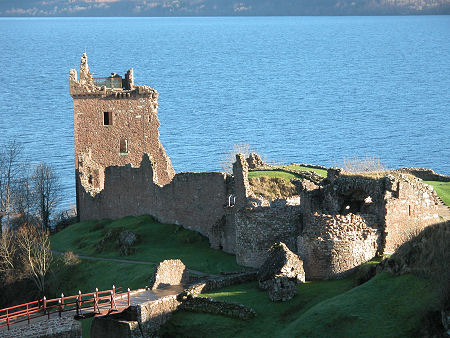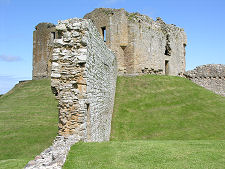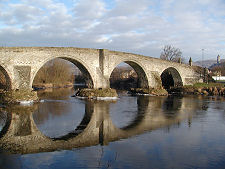 Urquhart Castle, Attacked by Andrew Murray |
Andrew Murray, also known as Andrew Moray, Andrew of Moray, or just Moray, lived from around 1270 to 1297. With William Wallace he jointly led the revolt that culminated in the Scottish victory over the English at the Battle of Stirling Bridge in 1297, and he was the father of Sir Andrew Murray, who served as Guardian of Scotland for periods in the 1330s. The wider picture in Scotland at the time is set out in our Historical Timeline.
The Murrays were a family of Flemish descent, who settled in Moray during the reign of David I. They were among the many families, most of French or Norman descent, invited from England by David to help him establish his authority in the Gaelic-speaking areas of Scotland.
Andrew was the oldest son of Sir Andrew Moray of Petty, who based his activities on Avoch Castle on the Black Isle, on the opposite side of the Moray Firth to Inverness. Sir Andrew Moray was well connected. His second wife, and Andrew Murray's step-mother, was Euphemia Comyn, the sister of John Comyn, Lord of Badenoch, who in turn was a nephew of King John Balliol. Sir Andrew's brother, Sir William Moray, had large estates in Lanarkshire which he administered from the family seat at Bothwell Castle.
In 1296, Edward I of England invaded Scotland. Andrew, his father, and his uncle fought with the losing Scottish army at the Battle of Dunbar on 27 April 1296. Edward I went on to depose King John Balliol, while the important prisoners taken by the English at the Battle of Dunbar were taken south in chains. The most important, including Sir Andrew Moray and John III Comyn, were taken to the Tower of London, where he was to remain. Andrew Murray was imprisoned in Chester Castle, from where he escaped, returning to Avoch by May 1297.
By coincidence, this was also the month in which William Wallace sacked Lanark Castle and began his uprising in the south. Back in the north, Andrew Murray was joined at Avoch by large numbers of supporters, including the burgesses of Inverness. Murray's first move was to besiege Urquhart Castle on Loch Ness, though without siege equipment and after a night attack failed, he withdrew, instead campaigning across Moray and Aberdeenshire, capturing Duffus Castle.
Edward I responded by sending a number of the Scottish nobles he had captured north, under oath to stamp out Andrew Murray's rebellion. Among them were Henry Cheyne, Bishop of Aberdeen, Sir Gartnait of Mar, and John Comyn, Earl of Buchan. The two sides met in Speyside, but it seems Andrew Murray was allowed to withdraw without pursuit: the released nobles later telling Edward that the nature of the land had prevented them attacking. It was unlikely that Edward believed them. Edward then offered to release Sir Andrew Moray to fight on the continent, on condition that his son Andrew Murray went to London to take his place in the Tower.
Andrew Murray did not do so, instead joining forces with William Wallace. On 11 September 1297, Murray and Wallace led the Scottish forces that decisively defeated the English at the Battle of Stirling Bridge. Scottish casualties at the battle were relatively light, but among them was Andrew Murray, who was badly wounded. He died of his wounds some time later. His seal was used alongside Wallace's on letters written on 11 October and 7 November, so it is usually assumed Murray died in November 1297: others argue that Wallace could have signed these letters with their joint seals and that Murray might have died soon after the battle.
Had Andrew Murray not died after the Battle of Stirling Bridge it is likely he would be much better remembered than he is. In many ways he was the senior partner with William Wallace. His campaign in the north had been more devastating to Edward's interests in Scotland than Wallace's in the south, and it is striking that the only major battle that Wallace won was with Murray in joint command. But Murray did die, and Wallace went on to briefly become Guardian of Scotland and, more enduringly, to become one of the most influential legends to emerge from Scottish history. Murray was survived by his son, who went on to become Sir Andrew Murray, Guardian of Scotland for periods during the 1330s.


